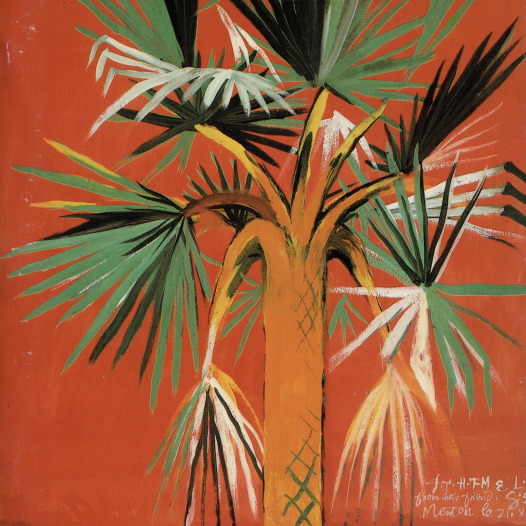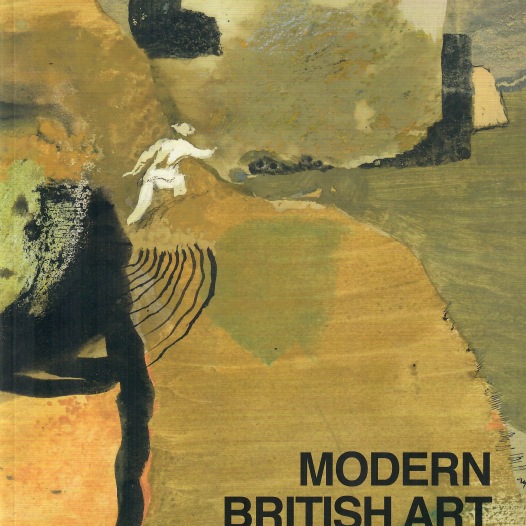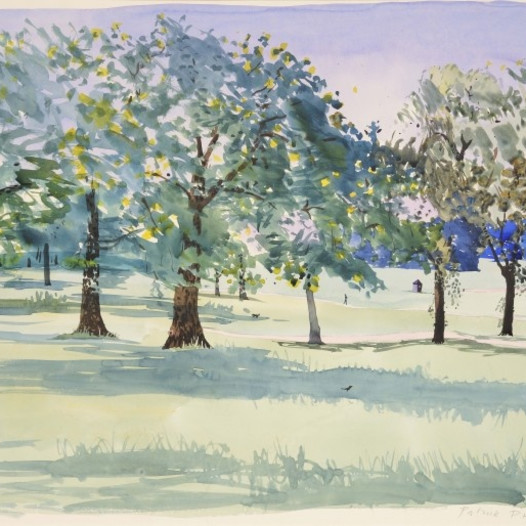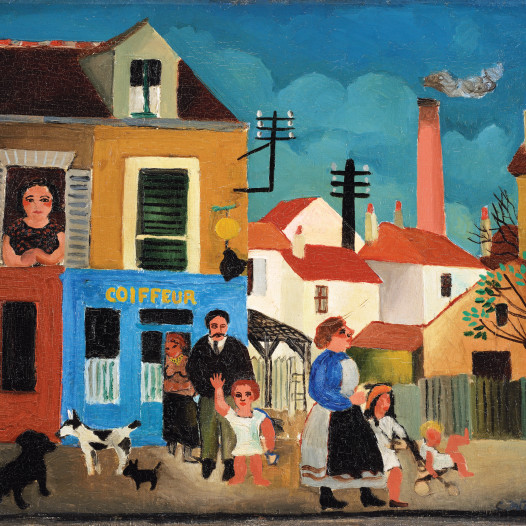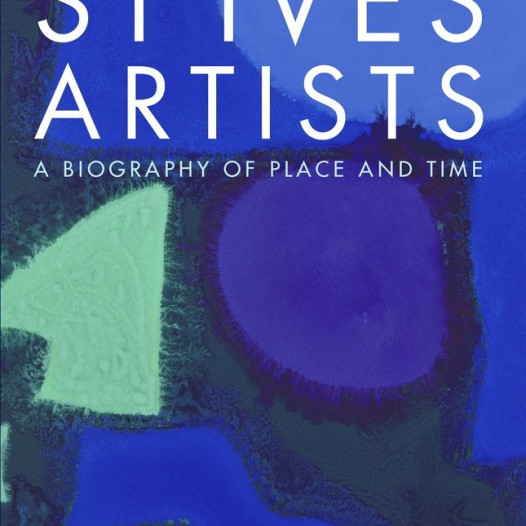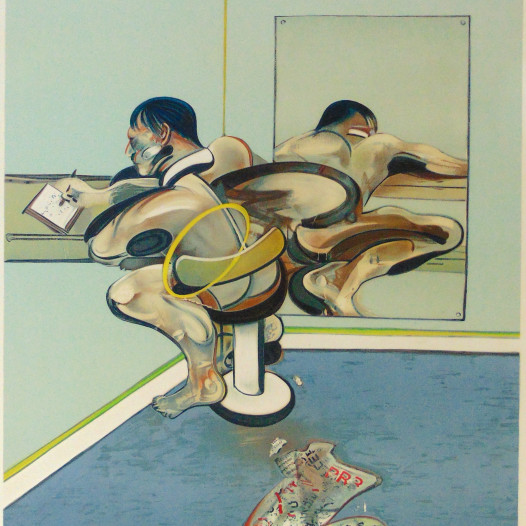Christopher Wood
1901–1930Born in Liverpool in 1901, Christopher Wood was a member of the London Group and the Seven and Five Society. He initially studied architecture and medicine at Liverpool University (1919-20), when he met Augustus John, who persuaded Wood to become a painter.
Wood moved to London in 1920, having abandoned his university career. There, he met Alphonse Kahn, who invited him to Paris, where Wood enrolled at the Académie Julian. He met José Antonio de Gandarillas in Paris, and the two began to live together, Wood financially reliant on his partner. Through Gandarillas and others, he met Jean Cocteau and Picasso in 1923, as well as Diaghilev, for whom he produced unused set designs in 1926. Wood also started smoking opium, influenced by Gandarillas and Cocteau, a habit that had blossomed into an addiction by 1930.
Between 1922-24, Wood travelled to North Africa and around Europe, then briefly back to his parent’s home in Broad Chalke, Wiltshire, where he painted several works, figurative depictions of country landscapes, populated by small houses and stylised trees. Wood made repeated trips to Paris in this period, but also began to establish himself in Britain. In 1926 he joined the Seven and Five Society (where he met Ben and Winifred Nicholson, who had effectively taken control of the organisation) and the London Group. His friendship with the Nicholsons provided a great steadying influence in Wood’s otherwise rackety life. He exhibited with them at the Beaux Arts Gallery in 1927, and they supported him when his elopement with Meraud Guinness in 1927 failed. He journeyed with the Nicholsons down to St Ives, where he and Ben Nicholson met Alfred Wallis, the unlearned painter of boats who provided a crucial influence for both men. Wood lived near Wallis for a few months.
Wood had a solo exhibition at Tooth’s Gallery in 1929 (where he met his biggest supporter, Lucy Wertheim, who began to purchase his work), and then a joint show with Nicholson at the Galerie Bernheim, Paris, in 1930. Paintings for the latter were created from 1929-30, when Wood made several trips to Brittany. These were of boats in harbour, and scenes from seaside towns. There is a definite indebtedness to Wallis in the depiction of boats, seen side on, in an almost primitive style, even borrowing a similar palette of dirtied colour. More of these paintings were due to be exhibited at the opening of the Wertheim Gallery, London, late in 1930. However, this was not to be. In August 1930, Wood went down to Salisbury to meet his mother, and, upon leaving her, threw himself on the rails. He had been suffering from paranoia, perhaps as a result of withdrawal from his all-consuming opium addiction. In the month of his death, he painted a work that approached Surrealism (indicating, perhaps, the path he might have taken, had he lived).
Posthumous exhibitions were held in order to celebrate Wood’s life and work—one at the Wertheim Gallery, in 1931, then at the Lefebvre Galleries in the following year. His paintings were displayed in the British Pavilion at the Venice Biennale, as well as in a major retrospective by the Redfern Gallery in the New Burlington Galleries, both in 1938.
Works
-
 Christopher WoodReclining Nude, 1928Oil on canvas54 x 92 cm%3Cdiv%20class%3D%22artist%22%3E%3Cspan%20class%3D%22artist%22%3E%3Cstrong%3EChristopher%20Wood%3C/strong%3E%3C/span%3E%3C/div%3E%0D%3Cdiv%20class%3D%22title%22%3E%3Cem%3EReclining%20Nude%3C/em%3E%2C%201928%3C/div%3E%0D%3Cdiv%20class%3D%22medium%22%3EOil%20on%20canvas%3C/div%3E%0D%3Cdiv%20class%3D%22dimensions%22%3E54%20x%2092%20cm%3C/div%3E
Christopher WoodReclining Nude, 1928Oil on canvas54 x 92 cm%3Cdiv%20class%3D%22artist%22%3E%3Cspan%20class%3D%22artist%22%3E%3Cstrong%3EChristopher%20Wood%3C/strong%3E%3C/span%3E%3C/div%3E%0D%3Cdiv%20class%3D%22title%22%3E%3Cem%3EReclining%20Nude%3C/em%3E%2C%201928%3C/div%3E%0D%3Cdiv%20class%3D%22medium%22%3EOil%20on%20canvas%3C/div%3E%0D%3Cdiv%20class%3D%22dimensions%22%3E54%20x%2092%20cm%3C/div%3E -
 Christopher WoodThe Barber's Family, 1927Oil on canvas laid on board38 x 46 cmSigned and dated lower right%3Cdiv%20class%3D%22artist%22%3E%3Cspan%20class%3D%22artist%22%3E%3Cstrong%3EChristopher%20Wood%3C/strong%3E%3C/span%3E%3C/div%3E%0D%3Cdiv%20class%3D%22title%22%3E%3Cem%3EThe%20Barber%27s%20Family%3C/em%3E%2C%201927%3C/div%3E%0D%3Cdiv%20class%3D%22signed_and_dated%22%3ESigned%20and%20dated%20lower%20right%3C/div%3E%0D%3Cdiv%20class%3D%22medium%22%3EOil%20on%20canvas%20laid%20on%20board%3C/div%3E%0D%3Cdiv%20class%3D%22dimensions%22%3E38%20x%2046%20cm%3C/div%3E
Christopher WoodThe Barber's Family, 1927Oil on canvas laid on board38 x 46 cmSigned and dated lower right%3Cdiv%20class%3D%22artist%22%3E%3Cspan%20class%3D%22artist%22%3E%3Cstrong%3EChristopher%20Wood%3C/strong%3E%3C/span%3E%3C/div%3E%0D%3Cdiv%20class%3D%22title%22%3E%3Cem%3EThe%20Barber%27s%20Family%3C/em%3E%2C%201927%3C/div%3E%0D%3Cdiv%20class%3D%22signed_and_dated%22%3ESigned%20and%20dated%20lower%20right%3C/div%3E%0D%3Cdiv%20class%3D%22medium%22%3EOil%20on%20canvas%20laid%20on%20board%3C/div%3E%0D%3Cdiv%20class%3D%22dimensions%22%3E38%20x%2046%20cm%3C/div%3E -
 Christopher WoodThe PickpocketInk on paper29 x 38 cm%3Cdiv%20class%3D%22artist%22%3E%3Cspan%20class%3D%22artist%22%3E%3Cstrong%3EChristopher%20Wood%3C/strong%3E%3C/span%3E%3C/div%3E%0D%3Cdiv%20class%3D%22title%22%3E%3Cem%3EThe%20Pickpocket%3C/em%3E%3C/div%3E%0D%3Cdiv%20class%3D%22medium%22%3EInk%20on%20paper%3C/div%3E%0D%3Cdiv%20class%3D%22dimensions%22%3E29%20x%2038%20cm%3C/div%3E
Christopher WoodThe PickpocketInk on paper29 x 38 cm%3Cdiv%20class%3D%22artist%22%3E%3Cspan%20class%3D%22artist%22%3E%3Cstrong%3EChristopher%20Wood%3C/strong%3E%3C/span%3E%3C/div%3E%0D%3Cdiv%20class%3D%22title%22%3E%3Cem%3EThe%20Pickpocket%3C/em%3E%3C/div%3E%0D%3Cdiv%20class%3D%22medium%22%3EInk%20on%20paper%3C/div%3E%0D%3Cdiv%20class%3D%22dimensions%22%3E29%20x%2038%20cm%3C/div%3E
